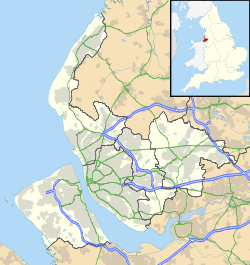- Newsham Park Hospital
-
Newsham Park Hospital 
Newsham Park HospitalGeneral information Location Liverpool, England, United Kingdom Coordinates 53°25′16″N 2°56′05″W / 53.421061°N 2.934755°W Completed 1874 Design and construction Client Liverpool Seamen's Orphan Institution Architect Alfred Waterhouse Newsham Park Hospital is a grade II listed building in Liverpool, Merseyside, England (grid reference SJ379920). It now lies derelict but was previously a hospital and before that it was an orphanage.
Contents
History
Foundation
Before 1869 there was no institution in Liverpool for the support and education of the orphans of British seamen. The first move to establish such an institution was made by a group of leading Liverpool ship-owners in 1868.
The sponsors of the project comprised a group of ship-owners and merchants who for some time had been concerned how best to help the widows and families of deceased Merseyside men including those lost at sea. Members of the public were invited to attend a meeting at the Mercantile Marine Service Association Rooms on 16 December 1868, at which the resolution to found such an establishment was proposed by Ralph Brocklebank and Bryce Allan, both leading ship-owners and philanthropists. James Beazley, another leading ship-owner, was invited to be chairman of the committee to establish an orphanage.
One of the ship-owner sponsors wrote on 17 December 1868 to nine of his colleagues offering to donate £500 to start a building fund if they would donate the same amount. There was an immediate response to this letter, and further donations were received following a more widespread public appeal. Within a few months there was enough money for the General Committee to look round for a temporary home.
On 9 August 1869 the Liverpool Seamen's Orphan Institution opened in temporary rented accommodation in Duke Street, and by the end of that year there were 46 boys and 14 girls in residence.
On 7 April 1870 Liverpool Town Council gave 7000 square yards (0.6 hectares) of land on the north-east side of Newsham Park to construct a Seaman's Orphan Institution. On 31 January 1874 the children from the temporary home in Duke Street were transferred, together with 46 newcomers. In addition to the 200[clarification needed] children at the orphanage, the committee also looked after children on an outdoor relief basis.
Further progress
From the outset the education of the children was given top priority, and from 1892 the boys' school, and from 1898 the girls' school were administered strictly under government regulations, and the institution received a share of the Parliamentary Grant from the Education Department.
By 1899 there were 321 children in the orphanage, while 508 were receiving outdoor relief in the form of monetary grants and clothing. Children of all religious denominations were assisted, with preference given to orphans of British seamen connected with the Port of Liverpool. The scholastic and religious instruction were under the supervision of the Church of England Chaplain.
The institution was formally opened on 30 September 1874 by the Duke of Edinburgh, the "Sailor Prince", fourth son of Queen Victoria. In May 1886, the Queen herself visited the institution, and added her name to the list of patrons.
In July 1900 the swimming baths were formally opened. They were financed by sponsors including the Brocklebank Baronets and Sir Robert Houston, 1st Baronet, its designer.
The war years
The First World War brought problems, and by 1918 one thousand orphans were being assisted. Royal appreciation of the work was shown from time to time by visits to Newsham Park, and following a visit by Queen Mary and the Princess Royal in 1921 the King bestowed upon the institution the title "Royal" and granted it a Royal Charter of Incorporation.
In the inter-war years the institution made continued progress.
During the Second World War the children were evacuated to "Hill Bark", Frankby, Wirral, the country home of Mr E.B Royden, a devoted friend and committee member. Here the children remained and flourished throughout the war.
Post-war and closure
In 1946, preparations were made for a return to Newsham Park, but with the great expansion in the country's social service schemes, many surviving parents were understandably reluctant to place their children in the orphanage. This led to a gradual decline in the number of resident children. New laws prohibited children under 11 years of age being educated at the same school as older children, and young children living in an institutional school.
Despite Newsham Park's endowment, financial difficulties were increasing and there seemed little prospect of bridging the widening gap between income and expenditure. As a result the orphanage was closed on 27 July 1949 while continuing to implement the objectives of the founders in providing means for the education and maintenance of the children of deceased British merchant navy seamen.
Places in various schools were found for those then being housed and educated at Newsham Park. Most were transferred to the Royal Merchant Navy School at Bearwood, fees, etc. being borne by Newsham Park.
The sale of the premises at Newsham Park to the Ministry of Health for use as a hospital realised £125,000 in 1951; the proceeds were forwarded to the Charity Commissioners for investment.
The committee continued to provide support to orphaned seamen's children on a non-resident basis, thus continuing to pursue the original objectives of the institution's founders, with special emphasis on education.
The work of the Institution in providing for the relief and education of the orphaned children of seamen continues today, and in 1969 the Institution celebrated its centenary.
In 2004 a plan by its owners Gateway Properties to develop the building into flats was defeated by local regeneration campaigners, and in July 2007 the site was put up for sale.
External links
Categories:- Alfred Waterhouse buildings
- Buildings and structures completed in 1874
- Grade II listed buildings in Merseyside
Wikimedia Foundation. 2010.

